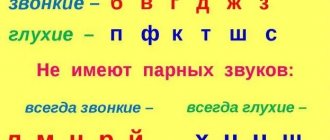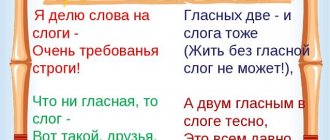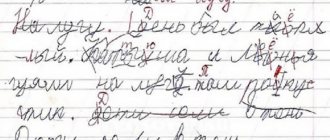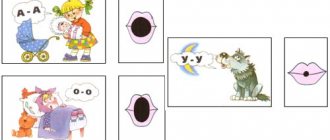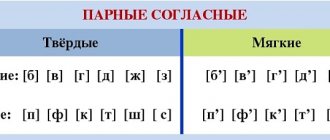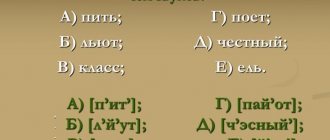How the closed and open syllables differ in English is not necessary to study if you do not cultivate a professional level in yourself. Although the topic itself does not present any serious difficulties, you need to know the basic rules. The standards for syllable division of the English language differ significantly from Russian phonetics.
The general rule is that the number of syllables corresponds to the number of vowel sounds.
This means that you should not look at the letters, but listen to the pronunciation of the word, since silent vowels, diphthongs, etc. are abundant in the English language.
In addition, so-called sonorant consonants can also be syllabic, so the word “mild” will be divided in this way: mi|ld. In the future it will become clear why this happens.
The syllable division is made from the end of the word: student – stu|dent, money – mo|ney, permission – per|mis|sion.
A consonant that is on the boundary of two syllables is thus adjacent to the vowel that follows it. Doubled sounds are divided. All this matters if you need to figure out how to pronounce a particular unfamiliar word. Also, for this you need to know about closed and open syllables in English.
Open syllables
The main rule of an open syllable in English is that it must end in a vowel. In this case, the vowel is read exactly the same as in the alphabet and ultimately produces a long sound.
Main characteristics of a syllable:
- Such a syllable does not have a consonant after the vowel in the syllable. (for example in the words: go, my, no);
- Usually has the letter e at the end of the word, which comes immediately after the vowel (for example in the words: pie, toe, bye);
- Immediately after the consonant letter there is a silent (or unreadable) vowel e (for example in the words: name, take, pupil);
- Immediately after the stressed vowel there is a consonant + le (for example in the words: table, noble).
The same rule may apply to some monosyllabic words, such as: me, go, she and some others.
There are also exceptions to this rule. It is very important to remember that in the words: love , some , done , none , dove - the letter “o” in the first syllable is read exactly the same as the short “a”.
Conditionally open
These two types of syllables are sometimes also called half-closed. They end in "r" or "re". In theory, in this case these will be closed and open syllables, respectively.
In English, everything is different, and vowels, being in front of these letter combinations, acquire a new, more complex sound; before “re”, some of them even become diphthongs.
- In the first case, if we are talking about syllables ending in r, everything will be like this:
- - o [ɔ:] – port, short, world;
- In the second, if there is a “re” after the vowels, they will sound differently:
- - a [ɛə] – to care, nightmare;
- - e [iə] – here, here;
- - u [juə] – cure, sure, pure;
In addition to the fact that open and closed syllables in English, as well as the third and fourth types affect the reading of certain vowels, there are a huge number of letter combinations that also have a special sound. This knowledge can be obtained both in theory and simply by memorizing the transcription of words when encountering them in practice.
Closed syllables
This is the syllable that occurs most often. It ends in a consonant (one or more), and the vowel letter in the syllable is read briefly. We have selected several examples for you that will help you remember the rule better:
As always, there are a few exceptions to this rule that you need to keep in mind:
- The letter “a” before “s” and the combination “th” is always read as a long “a”: past, master, glass, father, path.
- The letter “a” after “w” is always read as a short “o”: was, want, wasp.
- In some words, the letter “u” is read exactly the same as in an open syllable: put, pull, bull, push.
- The letter “o” in combination with “–st” is also read briefly: most, lost, host.
Definition of a stressed syllable
English is a freely accented language. When pronouncing similar-sounding words correctly and, accordingly, when writing transcriptions, the main and secondary stresses are of great importance.
Difficulties often arise when determining word stress in English words.
Rules for basic stress in English words:
- Determine the presence of prefixes and suffixes, since prefixes shift the stress to the root, and individual suffixes indicate a stressed syllable by their presence.
- Suffixes that always come after a stressed syllable:
-ion, ‑ious, ‑ial, ‑ian, ‑iant, ‑iance, ‑ient, ‑ience and ‑ic ‚-ical.
Example: republic [rI'pAblIk] - republic.
- The stress retains its position (as in the original word) in derived words that are formed by adding suffixes: ‑ly, ‑ful, ‑less, ‑nees, ‑ism, ‑ing, ‑er, ‑or, -(e)d, - (e)s.
- We determine the actual (pronounced) syllables in a word, since stress is distributed between them.
- The majority of all English words used have no more than three syllables, so:
- Without taking into account the prefix (prefix), the stress in words consisting of 2 syllables falls on the first syllable;
- If a two-syllable word contains a suffix, then the stress falls on the second syllable (counting syllables from right to left).
- In words consisting of 3 or more syllables, the third syllable from the end of the word is stressed.
- In polysyllabic words (more than four syllables), the secondary stress is placed one syllable to the left of the main one.
Exceptions to the rules are words borrowed from other languages:
Rules for the pronunciation of vowels in a stressed open syllable
For Russian-speaking people, it is especially difficult to understand such a number of vowel sounds with a minimum number of vowel letters. Vowel sounds are of the following types:
- short vowel sounds;
- long vowel sounds;
- diphthongs of vowel sounds (a combination of 2 vowels).
After the word is divided into syllables and the main stress is correctly determined, you can read the word, guided by the following rules:
In a stressed open syllable, the open vowel is read as in the alphabet:
- “a” - [eı];
- “o” – [əʊ]; Exceptions: "o" – [Λ] after "m", "th", "n" and "v". Examples some, dove, come.
- "u" – [ju:] like [u:], if the letter comes after:
- letters “r”: rude [ru:d] - rough;
- consonant+l: flute [flu:t] - flute;
- hissing sound: June [dʒu:n] – June.
- “e” – [i:], doubling the letter “e” – [i:]. Example: see [si:] – to see. The letter "e" is silent at the end of words, except in monosyllabic words, where it is the only vowel. Example: he [hi:] - he, me [mi:] - I, be [bi:] - to be.
- “i” – [aı]. Exception: “i” – [ı] only in the pronunciation of the verb “to give”.
- “y” – [aı].
Cases when the sounds: “a”, “i”, “u” end a stressed syllable are not entirely natural for English speech, and this indicates a foreign origin or an abbreviation of the word.
Silent vowel "E"
- A voiceless syllable or a syllable with a silent vowel "e" at the end.
- Consists of a vowel, followed by a consonant, and then the letter “e”, which is not pronounced.
- As a rule, this is the final syllable in the root part of the word.
Reading examples: fake [feɪk] – counterfeit, centime ['sɑ:nti:m] – centime, commune ['kɔmju:n] – community etc.
In English, silent vowels at the end of words are considered to indicate that the syllables are open. Accordingly, vowels are read in exactly the same way.
Tips for learning English syllables
- Record your speech with a voice recorder to identify problematic aspects of pronunciation that you should work on in the future.
- Take your time and watch your breathing, as speaking speed is not always an indicator of fluency and clear pronunciation.
- Close your eyes and visualize the process of creating sound as you speak.
- Pronunciation is a physical skill, since when speaking a foreign language you use different facial muscles. For this reason, always practice sounds that don't come out.
- Good pronunciation is not just about mastering individual sounds. Pay attention to intonation and stress.
- Practice in front of a mirror, paying attention to the position of your mouth and tongue.
- Listen to English-language podcasts, watch movies and repeat after native speakers.
- Problems with pronunciation persist because we are afraid of making mistakes. Do not be afraid.
- Practice the language when you are alone in a comfortable environment.
- Find a language learning buddy and compare notes. A little outside criticism is a good thing.
- Sing your favorite songs in English, feel the rhythm and accents of intonation.
- And finally, be sure to read the article on the rules of reading English vowels and consonants to be sure to become a master of phonetics.
Reading rules in English: theory and practical work
Mastering the rules of reading may seem like a daunting task, but it is one of the very first and most important steps in learning a language. After all, reading is one of the wonderful methods of replenishing vocabulary, repeating previously learned grammatical structures, and simply a way to have a pleasant and useful time.
You can remember what an open and closed syllable is here. See tables and workshop here.
Sounds and letters
44 sounds in the English language - 20 vowels and 24 consonants .
The English alphabet has 26 letters : 6 vowels (a, e, i, o, u, y) and 20 consonants (bcd f, g, h, j, k, l, m, n, p, q, r, s , t, v, w, x, z).
Since the number of sounds exceeds the number of letters, some letters can convey several sounds. To convey individual sounds, letter combinations (transmitting 2 or more letters of the same sound).
One sound can be conveyed by different letters and letter combinations. Sometimes one letter combination can convey different sounds. Therefore, in the phonetics of the English language, transcription - a system of signs in which each sign conveys only one sound.
Transcription shows how a word should be pronounced, i.e., what sounds it consists of. Traditional English transcription signs are used in bilingual (translation) dictionaries.
You can get acquainted with the transcription and pronunciation features of English words in more detail here.
In English, vowel length is very important because it affects the meaning of a word. This means that words with the same vowel of different lengths will differ in meaning, for example: sheep [ʃi:p] - sheep, ship [ʃɪp] - ship, live [lɪv] live - leave [li:v] - leave , leave. The length of a vowel in transcription is indicated by two dots after the vowel sound.
Intonation
Intonation , or melody of speech , is a decrease or increase in tone during speech. Each language has its own, unique melody, which makes the sound of the language special.
There are two main intonation patterns in English: falling (tune one) and rising (tune two) .
Descending and rising tones of speech are indicated by an arrow: if the arrow before the last stressed syllable is directed downward, then the intonation of the sentence is descending; if the arrow is directed upward, then the tone rises:
- I live in ↓ Tokyo.
- Do you live in ↑ Tokyo?
Descending intonation is most often used in affirmative and imperative sentences, special questions (questions that begin with question words), exclamatory sentences, and rising intonation in general questions, requests, enumeration.
- Kate is ↓ twenty.
- ↓ Open the window.
- Where did she ↓ go?
Examples of using rising intonation:
- Do you speak ↑ English?
- May I ask you a ↑ question?
- I have a ↑ mother, a ↑ father, a ↑ sister and a ↓ brother.
Accent
Each language has its own rhythm. In an English sentence, stressed syllables are generally pronounced at regular intervals.
Stress in a sentence can be nouns, adjectives, main verbs, numerals, adverbs, interrogative and demonstrative pronouns. A stressed syllable is indicated by an accent sign ( ˈ ).
In English transcription, the stress comes before the stressed syllable.
Types of syllables
The reading of a vowel depends on stress and its position relative to other letters. There are 4 types of syllables in English:
- Closed syllable - a syllable ends with a consonant: ten, not, spot.
- Open syllable - a syllable ends with a vowel: mice, no, cry.
- Vowel + r + consonant - card, cart, fork.
- Vowel + r + vowel - here, pure, rare.
Reading vowels in four types of syllables
| Letter | Closed syllable | Open syllable | Vowel + r + consonant | Vowel + r + vowel |
| a | rat [ræt] | rate [reɪt] | star [stɑː] | stare [steə] |
| o | hot [hɔt] | hope [həup] | sport [spɔːt] | more [mɔː] |
| u | bus [bʌs] | use [juːz] | turn [tɜːn] | pure [pjuə] |
| e | ten [ten] | Pete [piːt] | her [hɜː] | here [hɪə] |
| i | still [stɪl] | smile [smaɪl] | bird [bɜːd] | fire ['faɪə] |
| y | system ['sɪstəm] | type [taɪp] | myrtle ['mɜːtl] | tire ['taɪə] |
Reading letter combinations
Some consonants in English affect the reading of adjacent vowels.
Reading vowel letter combinations
- a+s+consonant - [a:] - ask, fast, pass;
- a+l+consonant - in a closed syllable under stress - [ɔ:] - small, salt, tall;
- a+l+k (l is unreadable) - [ɔ:] - talk, chalk;
- wa, qua+r+consonant (r is not read) - [ɔ:] - war, warm, quarter;
- wa, qua+consonant (except r, l) - [ɔ] - want, quantity;
- wa, qua - in an open syllable - [ei] - wave, quake;
- ai, ay - under stress - [ei] - stain, day;
- au, aw - [ɔ:] - author, law;
- ea, ee - [i:] - sea, steel;
- ear - under stress, if this combination is not followed by a consonant - [iə] - dear;
- ear - before a consonant - [ə:] - learn, early;
- eer - under stress - [iə] - engineer;
- ew - if not after l, r, j - [ju:] - few, dew;
- ew after l, r, j - [u:] - flew, drew, jewel;
- i+ld - [ai] - mild;
- i+nd - [ai] - find;
- i+gh - [ai] - flight;
- o+ld - [ou] - old, gold;
- oo+k - [u] - took, look;
- oo + consonant - [u:] - mood, shoot, foot;
- oa - [ou] - road, load;
- ou, ow - [au] - out, town, loud;
- u - after r, l, j, and also before the vowel - [u:] - rule, blue, june;
- ui - [ju:] - suit;
- ui after r, l ,j - [u:] - fruit, sluice, juice.
Reading some consonants and their combinations
- c+e, i, y - [s] - palce, pencil, icy;
- c - in other cases - [k] - crystal, cubic, can;
- g+e, i, y - [dʒ] - page, giant, Egypt ( exception - get, give );
- g - in other cases - [g] - go, big, gave;
- j - [dʒ] - jet, just;
- s - at the end of a word, after a vowel and a voiced consonant, in the middle of a word between vowels - [z] - his, plans, because;
- s - in other cases - [s] - so, stand, lamps;
- th - [θ] - think, thin, thank; [ð] - this, that, with;
- sh - [ʃ] - show, ship;
- ch, tch - [tʃ] - inch, match;
- ph - [f] - physics, telephone;
- w - before r at the beginning of the word is not readable - write, wrong;
- qu - [kw] - quick, equipment;
- wh+vowel (except o ) - [w] - what, when, why;
- wh+o - [h] - who, whom, whose;
- ture - in unstressed position - [tʃə] - lecture, culture;
- tion, ssion - in unstressed position - [ʃn] - motion, session;
- ci+unstressed vowel - [ʃ] - social, electrician.
Remember [j]
Let's conjugate the word "works". Please note that there “e” after the vowel and means two sounds – “je” or “ye”: workjet - workju, work. “Workj” has not changed, so the ending here is only “-et”.
We inflect the noun “inspiration”: inspiration – inspiration – inspiration – the basis of “inspiration”, ending “-e”.
It happens that in very weak classes teachers do not require this. And if you just highlight the “e” in the word “inspiration” or the “et” in the word “works”, there will be no mistake.
But it’s more correct to highlight it the way I showed.
Learn to read English step by step
The question of how to learn to read in English arises in almost every person one day. Whether it’s learning for yourself or a requirement at work, knowledge of the first most popular international language will definitely come in handy.
Learn to read English
Stage No. 1. Learning the alphabet
As in any other language, the alphabet is the basis without which it is simply impossible to learn to read. There are different methods for learning to read in English, depending on who needs it - adults or children.
If your child needs to learn to read English from scratch, there are many ways to do this in the game. You can buy or make cards that, in addition to the letter itself, will have an easy transcription in Russian and a picture.
You can also use online games, where when you click on a letter, professional announcers will voice it, and animation will create a lasting association. Lyudmila Kamionskaya, author of textbooks on the English language, says: “It is very important to develop an interest in learning English from the very beginning.
After all, at first, the child will have to make an effort to understand, master, and consolidate something new.” The main task of parents in this case will be to create favorable conditions for learning and facilitate the learning process.
Because it is difficult for children to sit still, it is necessary to explain how to quickly learn to read English using simple and understandable rules.
How to teach a child to read English
For adults, the process will be easier. Many letters are easily compared to Russian, and the only thing you need to pay attention to is their correct pronunciation, which will later create the basis for spoken language and reading.
The most important requirement is to repeat the letters as long as there are spaces. Learning the alphabet in reverse or correct order is ineffective, since the order is more likely to be remembered than each letter separately.
You can separate the alphabet into different parts or even mix all the letters, and then learn it.
Afterwards, the correct order can be restored automatically when there are no problems with individual characters.
Stage No. 2. Learning the basic rules of reading
Open and closed syllables in English
Download this online lesson in PDF
- The rules of reading in the English language are an interesting phenomenon: sometimes the spelling of a word is so different from the pronunciation that even the English themselves joke about this: they say, we write “London”, but we read “Liverpool”.
- However, there is still a certain logic in English reading rules, so let’s try to figure it out and answer the question, what is a closed and open syllable in English ?
- The very first two rules concern the reading of vowels in open and closed syllables.
Reading vowels in an open syllable
- An open syllable is a syllable that ends with a vowel letter (most often the letter “e”), and the reading of vowels in it is also called “alphabetical”, since it is no different from the way letters are named in the alphabet:
- A - [ei] s a fe, l a te, m a de, c a ter
- O – [ou] n o te, r o se, c o de, g o
- E – [i:] P e te, m e , Ir e ne, d e l e te
- I (accented Y) – [ai] den y , k i te, l i ke, n i ce, s y ne
- U [ju:], [u:] r u de, t u ne, p u pil, t u be
Exceptions
However, the English language would not be an English language if there were no exceptions to the rules: there are words that you really want to read in strict accordance with the rule of “alphabetical” reading, but they are read differently. This is what you need to remember:
- Done, none, dove, love, some - in these words the letter “o” is read as a short sound “a”.
Reading vowels in a closed syllable
A closed syllable is the exact opposite of an open syllable, and therefore ends with one or more consonants. In syllables of this type, English vowels are read completely differently than they are called in the alphabet. Here you need to pay attention to which consonants follow the vowels.
- Here are examples:
- A – [ǽ] bl a ck, s a d, n a rrow, l a dder
- O - [ɔ] n o t, sl o t, bl o ck, o ffer
- U – [Λ] b u t, l u ck, n umber , u p
- E – [e] n e t, p e n, s e nd, p e pper
- I (Y) – l i p, s i tter, s y llable, t i p
- If the letter Y occupies an unstressed position at the end of a word, then it also produces a short sound: trul y , ugl y , spic y .
Exceptions
There are also exceptions to the rule of reading vowels: they concern consonant letters that come before and after vowels.
- A after W will be read as a short “o” sound: was, want, wasp, wander
- A before S and the combination “th” will be read as a long “a”: past, pass, master, glass, rather, father, path.
- U in some words is read as in an open syllable: push, put, pull, bush, bull
- O in combination with –st is read the same as in an open syllable: most, post, host.
These are the rules for reading English vowels in open and closed syllables: there is nothing tricky here, you just need to learn to distinguish where the syllable is open and where it is closed. A little practice and everything will work out.
How to remember the pronunciation of English consonants
Of course, it is difficult to explain pronunciation with pictures or words. Therefore, we advise you to watch this video before reading further.
The vowels here are drawn out for clarity (or audibility). It is not necessary to repeat them in the same drawn-out manner. In addition, we are now talking about the rules for reading English consonants, so concentrate on them.
We wrote more generally about the rules of reading here: Rules for reading English
Knowing English transcription is useful. This makes it possible to easily read and correctly pronounce an unfamiliar English word on your own, without outside help. Just look in the dictionary or use online services.
Don't be tempted to write English words using letters from the alphabet; there's no benefit to doing so. This technique does not work with either vowels or English consonants.
Remember that in English you need to know not only how each individual letter is read, but also the combinations of letters in a word. And, of course, you need to learn how to break words into syllables and determine what type they belong to: open or closed words. We wrote about this earlier in the article: How to read vowels
Today we will talk in more detail about the rules for reading consonants in English. The English alphabet has 20 consonant letters and another letter Y, which can represent both a vowel and a consonant. These letters convey 24 consonant sounds.
This picture shows sounds that are pronounced with a voice (on the left) and without a voice (on the right). However, you may notice that there are only 23 characters here, not 24. The fact is that the picture shows letters and pairs of letters, and not sounds in the form in which they are transmitted in transcription.
Now we come to the rules for reading consonant sounds. But before that, you definitely need to read this article: Transcription in English
When reading, consonants in English are not softened before vowels, and voiced consonants at the end of a word are not deafened; doubled consonants are pronounced as single consonants.
Now let's start getting acquainted with the rules for reading consonants in English.
Read also
Essay My favorite kind of sport in English with translation


